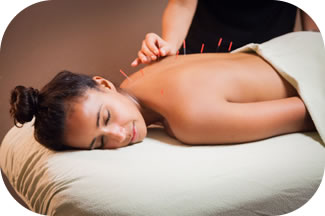Acupuncture and Massage
 Acupuncture is a traditional form of Chinese medicine that involves the insertion of small, thin needles into the body at certain “points.” It is also associated with the application of heat and pressure to these specific points. Acupuncture is commonly used in relieving pain, and is often used in addition to other forms of treatment for pain. One study published in Mayo Clinic Proceedings showed that acupuncture can relieve fatigue and anxiety in fibromyalgia patients for up to seven months after treatment (1). Based on their answers to the Fibromyalgia Impact Questionnaire, the acupuncture patients reported less fatigue and fewer anxiety symptoms after only one month of treatment. Acupuncture has been known to treat the symptoms of a number of pain disorders and other illnesses. It is believed to work because it relieves pressure and tension by moving it from one area to another, thereby creating a harmonious balance in the body. Acupuncture is performed by a licensed professional, and there is a high probability that you can find one close to the area that you live. Acupuncture is sometimes identified as a “pseudo science,” but in recent years it has gained more credibility in the United States. This increased exposure has also led to the steady rise of acupuncture research, which is finding more and more health benefits from acupuncture every day.
Acupuncture is a traditional form of Chinese medicine that involves the insertion of small, thin needles into the body at certain “points.” It is also associated with the application of heat and pressure to these specific points. Acupuncture is commonly used in relieving pain, and is often used in addition to other forms of treatment for pain. One study published in Mayo Clinic Proceedings showed that acupuncture can relieve fatigue and anxiety in fibromyalgia patients for up to seven months after treatment (1). Based on their answers to the Fibromyalgia Impact Questionnaire, the acupuncture patients reported less fatigue and fewer anxiety symptoms after only one month of treatment. Acupuncture has been known to treat the symptoms of a number of pain disorders and other illnesses. It is believed to work because it relieves pressure and tension by moving it from one area to another, thereby creating a harmonious balance in the body. Acupuncture is performed by a licensed professional, and there is a high probability that you can find one close to the area that you live. Acupuncture is sometimes identified as a “pseudo science,” but in recent years it has gained more credibility in the United States. This increased exposure has also led to the steady rise of acupuncture research, which is finding more and more health benefits from acupuncture every day.
Massaging sore muscles is another way to treat your fibromyalgia pain. Massage therapy is one of the oldest healthcare practices still being used today. Massage can improve circulation, increase the flow of nutrients to areas of pain, and decrease inflammation. Massage therapy is known to reduce heart rate, improve flexibility and range, and increase the production of the body’s natural chemicals, such as dopamine and serotonin. There are different types of massage techniques. One technique commonly used in treating fibromyalgia symptoms is Reflexology, which is an alternative medicine. It is constructed around a system of “zones” in the feet, hands, and head which correspond to specific organs and act as a guideline for a reflexologist. When finger pressure is applied to these zones, it relays a message of the internal organs that are in distress and directly benefits them, as well as relieves stress and benefits the overall health of the person receiving the massage. There are many other types of massage therapies, so research and talk with your doctor to discover a massage that works for treating your fibromyalgia.

